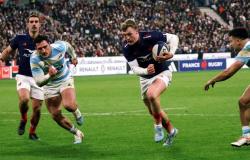Her sport is canoeing, she is part of the Union Sportive Neuvicoise, after a world title, she won the national title in two-seater canoeing and the French Cup in the same discipline. All with his sister and her partner. For Clara Gaubert, sport is done in the family.
It’s like a mini-portrait that we offer you today in Sport en Périgord. We invited Clara Gaubertkayaker within the Union Sportive Neuvicoise Canoë Kayak. She became French champion in two-seater canoeing with her sister Elsa and won the French Cup with her partner and father of her daughter, Clément Mozas. She tells us about her shopping.
His sport: canoeing, a family affair
In August 2024, Clara Gaubert and his sister Elsa Gaubertlicensed to the Union Sportive Neuvicoise Canoe Kayakbecame world champions in two-seater canoe sprint. After conquering the world, the two sisters became French champions in the same discipline a few weeks ago in the Olympic basin of Vaires sur Marne. A demanding pool with water movements that are difficult to tame. It is therefore with family that Clara achieves her best results, just like her title of winner of the Coupe de France in kayak and two-seater canoe with her boyfriend, the father of her daughter, Clement Mozas. Two titles to reward their investments throughout this season on the national circuit.
Union Sportive Neuvicoise Canoe Kayak
Medals and good rankings also by team
Clara Gaubert obtained a nice bronze medal in the ladies' canoe team race with two other friends from the Neuvic club, Sarah Tchao et Ninon Sammut. Two young players from the club. For Clara, it was a first in white water in this boat. But also a 10th place in kayak, which she considers more frustrating. We invited Clara Gaubert to tell us about her passion for her sport and her recent results, in Sport en Périgord.
France






